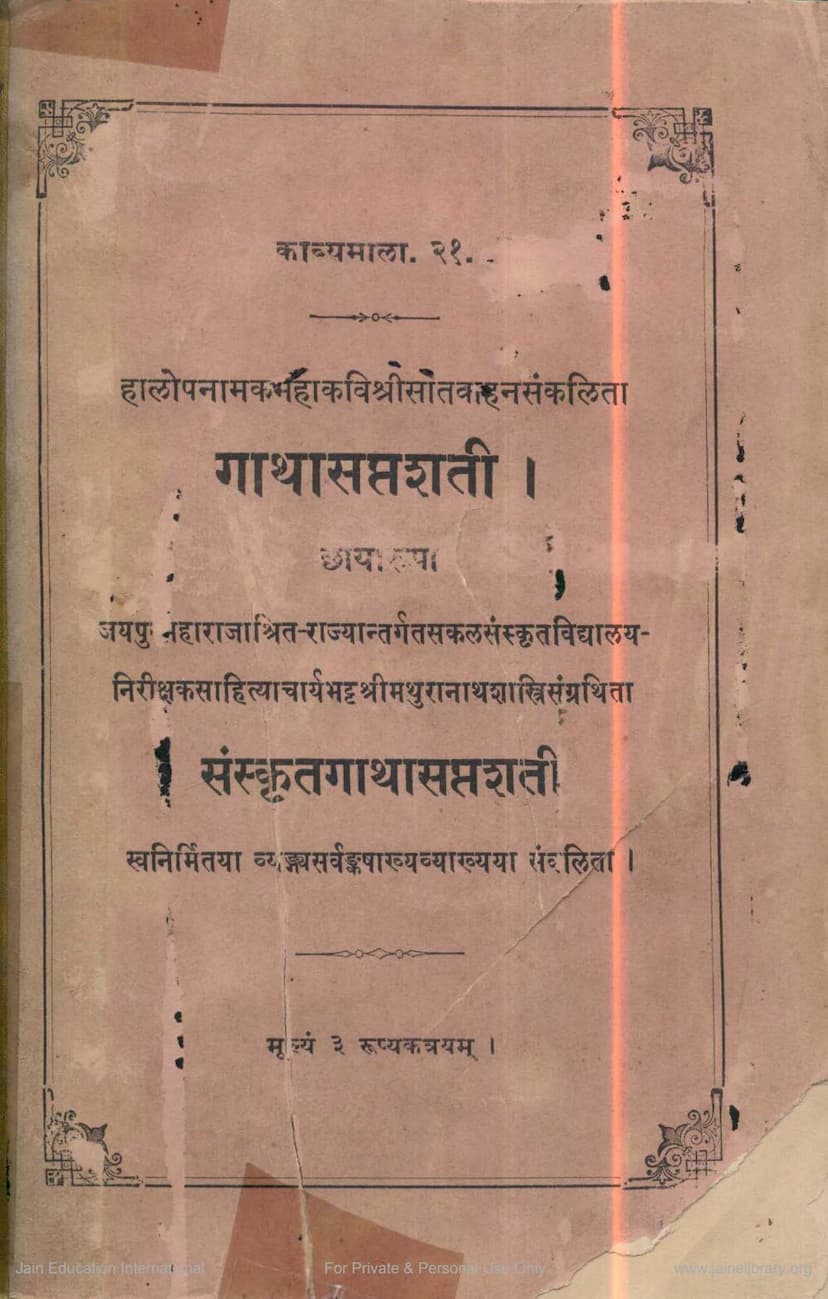Gathasaptashati
Added to library: September 1, 2025

Summary
The Gathasaptashati, compiled by the great poet Satavahana, is a collection of over 700 erotic verses in Maharashtri Prakrit, written in the Arya meter. It holds a significant place in the history of Sanskrit poetry as a lyrical masterpiece. The compilation is attributed to King Hala, who also contributed many verses, while the majority represent the work of other lyrical poets of his era. The verses are known for their sweetness, grace, freshness, and vividness.
This particular edition, published by Pandurang Javaji in Bombay in 1933, offers a unique presentation of the Gathasaptashati. It includes:
- The original Prakrit verses: The core text of the Gathasaptashati.
- A Sanskrit Gatha Saptashati: A new literal translation of the Prakrit verses into Sanskrit.
- A free metrical version in Sanskrit: A more interpretative rendering of the verses in Sanskrit poetry.
- A Sanskrit commentary titled "Vyangya Sarvankasha": A new scholarly commentary by Sahityacharya Bhatta Mathura Nath Shastri of Jaipur. The commentary is noted for its elegant and flowing style, aiming to interpret the text while respecting artistic and aesthetic senses, thus aiding in the appreciation of the original verses' poetic flavor.
The foreword by S. A. Gopinath Kaviraj highlights the Gathasaptashati's importance and its extensive commentary tradition, noting that the present commentary by Pandit Mathura Nath Shastri is a welcome addition due to its scholarly depth and artistic appreciation.
The text also includes a detailed Gathanukramanika (index of verses), listing hundreds of verses with their attributed authors, often mentioning royal patrons or other poets. The Bhumika (Introduction) section delves into various aspects:
- The relationship between Sanskrit and Prakrit languages: Discussing the origins and evolution of Prakrit from Sanskrit, citing Hemachandra Acharya's view that Prakrit is derived from Sanskrit. It also addresses the debate about Prakrit being older than Sanskrit, refuting it by suggesting grammatical changes over time rather than direct precedence.
- The sweetness of Prakrit: Discussing the perception of Prakrit's sweetness compared to Sanskrit, particularly in erotic contexts, and referencing verses that highlight this preference.
- The influence of Buddhism and other philosophies: Mentioning the presence of Buddhist teachings and practices described within the text, such as verses depicting Buddhist monks, indicating the religious and philosophical milieu of the time.
- The compilation of the Gathasaptashati: Explaining that the work is an anthology of verses from various poets, not solely King Hala's composition, though he compiled and likely added many of his own. It touches upon the possible identity of Hala as Satavahana of the Andhra dynasty, placing him in the first century CE.
- The nature of the verses: Emphasizing the predominant theme of eroticism (Shringara Rasa) in the collection, with many verses depicting explicit descriptions of love and sensuality.
- The literary qualities: Highlighting the use of metaphors, similes, and other poetic devices that contribute to the verses' artistic and aesthetic appeal.
- Comparison with other literary works: Drawing parallels and distinctions with Sanskrit works like Amaru's Shataka, illustrating how Prakrit verses influenced later Sanskrit poetry.
In essence, the Gathasaptashati, as presented in this edition, is a significant collection of ancient Indian lyric poetry, celebrated for its erotic themes, linguistic richness, and the insightful Sanskrit commentary provided by Mathura Nath Shastri.